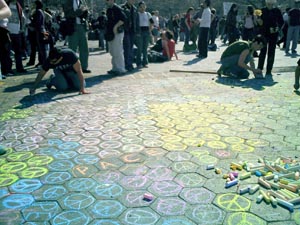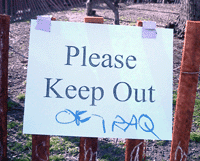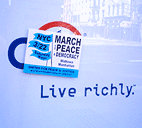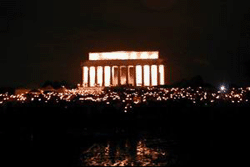iraq
Promises
Yeah... um... we believe you. But, um... actually, we really don’t want you here.
More promises and warnings, more images here and here of the millions of U.S. and U.K. leaflets dropped over Iraq.
Media Lies. News at 11.
“On Monday, March 31, the Los Angeles Times published a front-page photograph that had been altered in violation of Times policy.
The primary subject of the photo was a British soldier directing Iraqi civilians to take cover from Iraqi fire on the outskirts of Basra. After publication, it was noticed that several civilians in the background appear twice. The photographer, Brian Walski, reached by telephone in southern Iraq, acknowledged that he had used his computer to combine elements of two photographs, taken moments apart, in order to improve the composition.”
Bloggers are all abuzz about this. You can see the photo and its sources here. The improved composition shows the soldier slightly enlarged, both feet planted, and made to look as if his gun is pointing at the Iraqi.
I hope that such high-profile corrections will inspire skepticism, but worry that they lend the appearance of objectivity and diligence to the rest of the coverage. And thoroughness at the expense of the stories that are not being told.
“Times policy forbids altering the content of news photographs. Because of the violation, Walski, a Times photographer since 1998, has been dismissed from the staff.”
Sucks for Mr. Walski to lose his job, but I’m sure an experienced war photographer with an eye for composition won’t have too much trouble finding a market for his images. Perhaps he could try the Brits?
Otherwise, I look forward reading the Times’s call for Colin Powell to be fired for his misrepresentations. And Bush for his many lies.
See also Underxposed, on photographs and lies in the media.
Data
From iaslash:
“The current media spectacle that is the ‘war on Iraq’ produces a lot of good and bad infographics. I was surfing the web looking for them and a few thoughts struck me:
Infographics are somewhat expensive and time-consuming to produce, and are therefore in their nature providing context to whatever is going on on the ground. It is, however, _not_ in their nature to provide afterthought and analysis.
The policy concerning infographics of NRK (Norwegian equivalent of the BBC) is that it is important to not overuse infographics because they can create the impression that this is a computer game and not real war with real people really being blown into little pieces.”
...
This MSNBC graphic on the number of U.S. and U.K. deaths in Iraq is an improvement on this chart
|
The maintainers of Iraqbodycount.net comb the media and publish an estimate of Iraqi casualties via a banner you can include on your Web page. A number of bloggers have picked it up, but the raw numbers, particularly in this layout, just read like a score.
On the flip side are the graphic photos of U.S. and Iraqi corpses [warning: strong content] you won’t see on CNN. The images overwhelm with horror.
Yet, to me neither are as heart rending as this list of names, ages, and U.S. hometowns.
Under the Asphalt, the Cobblestones

Protestors after the march in New York City yesterday chalked messages around Washington Square Park.
As the U.S. invades Iraq and activists around the world take to the streets, here in New York I’m noticing how the city itself is increasingly used as a medium by the anti-war movement.
 Much of this is nothing new. City streets have always been checkered with posters, graffiti, flyers, and stickers. Subway ads are often annotated with running commentary, sometimes sexual but just as often critical of the ad and advertiser itself (or just blacked out teeth on a too-cheerful model.)
Much of this is nothing new. City streets have always been checkered with posters, graffiti, flyers, and stickers. Subway ads are often annotated with running commentary, sometimes sexual but just as often critical of the ad and advertiser itself (or just blacked out teeth on a too-cheerful model.)
 The anti-war movement has taken advantage of all of this. United for Peace and Justice stickers seem to be everywhere — on pay phones, mailboxes, street lamps, walls, and signage. The letters “STOP BUS” on the street are altered to read “STOP BUSH.” In the Baghdad Snapshot Action activists have simply postered ordinary snapshots from Iraq: “Quiet and casual, the snapshots show a part of Baghdad we rarely see: the part with people in it.”
The anti-war movement has taken advantage of all of this. United for Peace and Justice stickers seem to be everywhere — on pay phones, mailboxes, street lamps, walls, and signage. The letters “STOP BUS” on the street are altered to read “STOP BUSH.” In the Baghdad Snapshot Action activists have simply postered ordinary snapshots from Iraq: “Quiet and casual, the snapshots show a part of Baghdad we rarely see: the part with people in it.”
And then there was the march of over 200,000 people down midtown Manhattan yesterday.
But as the war escalates, so do the protests. And so does the reconfiguring of public space. Activists in San Francisco last week shut down traffic throughout the city with autonomous direct actions coordinated online. Activists hauled newspaper kiosks, cafe chairs and tables, and other street furniture into the streets. [article and photos]
What will be the government’s response? Some communities are all too familiar with locked down, fenced in, and video monitored public spaces. Once considered an invasion of privacy, cameras and other measures are increasingly justified as a legitimate response to terrorism. In the name of anti-terrorism, the City recently sought and won a loosening of the law that restricted on police surveillance of political groups. The restrictions were imposed by the settlement of a 1971 lawsuit over harassment of political advocacy groups by the Police Department’s so-called “Red Squad.”
Public amenities and the details of public life are being reshaped elsewhere in the fight against terrorism. In Israel, seating at bus stops is often bolted to the wall (no chair legs to hide things behind), every turnstile will soon have a metal detector installed, and every trash can on the street will be replaced with see-through plastic and wire receptacle. In Washington, D.C., subway trash cans are being replaced with bomb-resistant models. In the Tokyo subway, there are no trash cans at all anymore.
Not to mention Israel’s wall.
This week New York City announced Operation Atlas, additional security measures to try to protect us against terrorist attack during wartime. I’m not opposed to greater inspection of cargo entering the City, but have no doubt that the NYPD will use their new powers to target activists and political dissent. I also note that the plan, which costs $5 million a week comes at a time of severe budget cuts in NYC — and a deficit of nearly $4 billion. Was factored into the costs of the war?
Literature on cities is replete with the metaphor of public space as the site and the physical embodiment of democracy. In the weeks and months ahead, I wonder how our public space will change.
See NYC IndyMedia and Gotham Gazette’s page on New York City and the War.
Visual Protest
- March 16: Over 6,400 candlelight vigils are held in 129 countries. See photos and an interactive map.
- March 17: Window Lights for Peace is launched. An extension of the vigil.
- March 18: Danish Prime Minister Anders Fogh Rasmussen in Parliament in Copenhagen, doused with red paint by a protestor over his government’s backing of U.S. military action on Iraq.
Whether
Why the urgent rush to war RIGHT NOW?
The longer the delay, the greater the risk of U.S. casualties.
From NBC 10:
“If Iraq is to be invaded, the greater the delay, the greater the potential problems. Temperatures that average 80 on April 1, rise to 110 in June, with some days as hot as 120.”
“A typical American soldier goes into combat with a heavy load, so if you send your troops into the Middle East during the warm part of the year, you are risking problems from heat stroke, sunstroke and all kinds of elements,” said Gregory Urwin of Temple University.
“The problem in fall is the combination of dry air and strong winds, which creates bad dust or sandstorms,” Schwartz said.
“It was a dust storm that brought down a helicopter that was part of the attempt to rescue the hostages in Iran.
“Weather and moon conditions are ideal right now. There is also something called moonrise and moonset. Even next week, there will be four to six hours of total darkness each night. The modern military may be less-dependant on moon phases than in the past, but if they wait too long, potential problems increase and ideal weather is unlikely until next winter.”
If the invasion is delayed just a few more weeks, perhaps it won’t actually happen...
Aussie Military Pulls College Ads over Parody
From The Sunday Mail:
 “[Australia’s] Department of Defence appears to have pulled all its advertising from every student newspaper in the country because one Sydney publication made fun of it.
“[Australia’s] Department of Defence appears to have pulled all its advertising from every student newspaper in the country because one Sydney publication made fun of it.
The University of Technology Sydney student newspaper Vertigo ran a satirical ad to counter recruitment advertisements appearing in other publications and voice the editors’ opposition to war on Iraq.
Under the heading, ‘Have you got what it takes?’, the ad reads:
‘Why settle for an ordinary office job when you could have an extraordinary and challenging career as a pawn in the power games of politicians?
‘Not only will you get to take orders from arrogant pricks with buzz-cuts and ego complexes, but on special occasions you’ll get the chance to repress your moral integrity and accept orders to bomb the shit out of dark-skinned, tea towel wearing foreigners.’
Vertigo editor Jano Gibson said that after seeing the ad, the Defence Department pulled all advertising from every student paper in the country.
The move comes at a time when many student newspapers are struggling for financial survival and increasingly reliant upon advertising.
But far from being disappointed, the editors are thrilled that they have eliminated all Defence ads, saying the Government had played right into their hands.
Mr Gibson said Vertigo had already refused ads from the department and was trying to get other student papers to do the same.
‘In effect the Department of Defence has fulfilled our intentions in having a boycott across the rest of Australia,’ he told AAP.
‘We see it as a great victory that students are no longer being inundated with false representations of the defence forces.’”
From the Sydney IndyMedia:
“As an act of solidarity the parody will also be reprinted by Rabelais, the student paper of La Trobe University, and Lot’s Wife, the student publication of Monash University, with more possibly to follow.”
Anti-War TV
Anti-War Group Revives “Daisy” Ad Campaign, January 15, 2003
From AP:
“Revisiting one of the most effective television commercials in the annals of U.S. politics, a grassroots anti-war group has produced a remake of the ‘Daisy’ ad, warning that a war against Iraq could spark nuclear Armageddon.
The provocative 30-second commercial - released to the media Wednesday and appearing in 12 major U.S. cities on Thursday at a cost of $400,000, was prepared with the help of thousands of donations to the Internet-based group MoveOn.org.
 The original Daisy ad aired only once, during the 1964 presidential race. Produced by the campaign of incumbent Lyndon B. Johnson, it depicted a 6-year-old girl plucking petals from a daisy - along with a missile launch countdown and then a nuclear mushroom cloud. The suggestion was that if elected president, Republican Barry Goldwater might lead the United States to a nuclear war with the Soviet Union. Goldwater lost by a wide margin.
The original Daisy ad aired only once, during the 1964 presidential race. Produced by the campaign of incumbent Lyndon B. Johnson, it depicted a 6-year-old girl plucking petals from a daisy - along with a missile launch countdown and then a nuclear mushroom cloud. The suggestion was that if elected president, Republican Barry Goldwater might lead the United States to a nuclear war with the Soviet Union. Goldwater lost by a wide margin.
The 2003 version follows the same format, with an added montage of scenes of military escalation: burning oil wells, tanks in the battlefield, wounded soldiers, chaotic protests in a foreign city and an ambulance racing through U.S. streets. Then, a similar mushroom cloud, and the screen goes to black, with a dire warning: ‘War with Iraq. Maybe it will end quickly. Maybe not. Maybe it will spread. Maybe extremists will take over countries with nuclear weapons. Maybe the unthinkable.’
Then, another ‘10... 9... 8...,’ countdown, and a final message: ‘Maybe that’s why the overwhelming majority of Americans say to President Bush: let the inspections work.’
MoveOn.org’s leaders hope the ad will enliven the debate on the specter of war - and persuade Americans to oppose a military solution in Iraq.
‘We’re playing with matches in a tinderbox,’ Eli Pariser, MoveOn.org’s international campaign director said. ‘We wanted to run an ad that would highlight that very real possibility and help encourage a national discussion about the consequences of war.’”
MoveOn was started in 1998 by a couple of guys in Silicon Valley as an online petition encouraging Congress to resolve the long running investigation and impeachement proceedings of President Clinton. Their email list has since grown to 600,000 users, and the org now solicits contributions for its Political Action Committee, MoveOnPAC, whose campaign contributions “provide financial support to congressional candidates who embrace moderate to progressive principles of national government. Our intention is to encourage and facilitate smaller donations to offset the influence of wealthy and corporate donors.”
On the ad:
“In December, we asked members to contribute $27,000 for a print ad in the New York Times. Within days, we had more than $400,000 committed to our ad campaign. This allowed us to do several print ads, including an ad in USA Today. To follow up, we ran a radio ad created by Betsey Binet, one of our members. But once we saw the avalanche of support, we knew it was time to go to TV. Over the holidays, we worked on the spot you’ll see today. Our goal is to underline the risk of war and we’ve created a piece intended to provoke discussion and controversy....
The ad is airing on TV stations in Washington, DC, Los Angeles, San Francisco, Philadelphia, Chicago, Dallas, Miami, Boston, Minneapolis, Phoenix, Cleveland, Portland and Seattle. The ad buy is largely on cable networks, and will show heavily on public interest shows on channels such as CNN and MSNBC for the next week. At 10am today in each of these media markets, MoveOn volunteers will be running press conferences for the local media.”
A RealVideo version of the ad is up on their Web site.
It’s great to see the anti-war message breaking through the virtual ban on dissent in the mainstream media. I hope this will help create a space for the media to cover this weekend’s protests in D.C. and around the world.
The ad is also a good effort to try to show some of the consequences of the war on TV, but images of mushroom clouds don’t quite evoke the human cost for me. Cinematic explosions are pretty cheap these days. I suppose the zoom on the little white girl tries to do this by implication.
The message of the ad also seems a bit muddled. The ad urges Bush to “let the inspections work.” But then is it OK to go to war if the inspectons do in fact show Iraq in violation of UN resolutions? Wouldn’t the same costs apply if the U.S. attacked Iraq with the approval of the UN?
Make Love, Not War
From The Telegraph, UK:
Arabic love poem puts US Gulf base on red alert
By Jack Fairweather in Kuwait (Filed: 05/12/2002)
US marines in Kuwait were put on full alert yesterday after an unidentified person wrote a love poem in Arabic on a military vehicle.
The marines, unable to translate the simple phrase which begins many Arabic love songs, called the alert when they thought the message contained a terrorist threat. A translator was summoned and confirmed it was merely a poem, the words reading: “I love you forever. Your beauty is incomparable.”
“We’re not used to such things,” said one American soldier serving at Camp Doha, the American military base in Kuwait where troops are preparing for a possible war against Iraq.
It transpired that the message was not meant for the marines but for a lovesick teenager by the name of Fatima.
Pumpkins for Peace

“The Peace Pumpkin Project is a simple way to demonstrate your opposition to a war in Iraq. The idea is this: this year, carve the words ‘No War’ into your [Halloween] jack-o-lantern. That’s it. Do it to as many pumpkins as you want, and put them wherever you want as long as you don’t break the law or hurt anyone. If you’re carving-knife impaired, You can download a stencil in .pdf form. You could carve other words into the pumpkin, if you feel that ‘No War’ doesn’t express your opinion well enough, but I think it would increase the overall impact if people keep seeing the same simple message over and over: NO WAR.”
Found via Metafilter. Pumpkin shown is by the author of the Project Without a Name.





